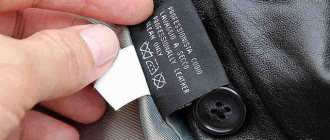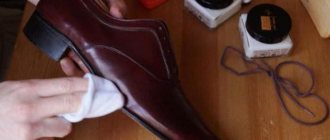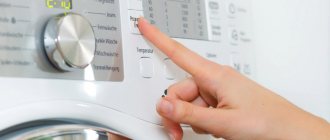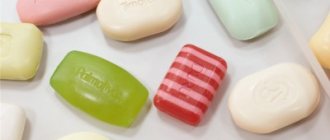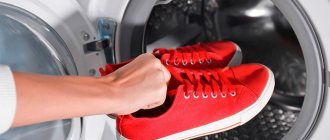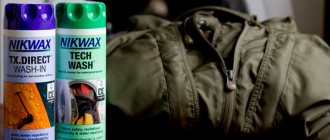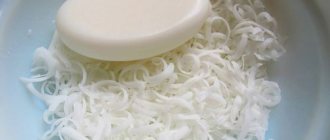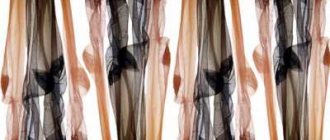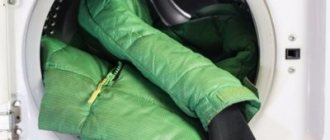Life in the modern world is teeming with variety. Store shelves are overflowing with a variety of products designed for specific purposes. Likewise, manufacturers of washing powders do not lag behind their colleagues. Now there is a wide variety of means, they all differ in their purpose. Powders began to be divided into hand washing and machine washing. Is it possible to ignore this and wash it with hand washing powder in an automatic machine?
What is the difference between hand washing powder and machine washing powder?
Modern products are divided into powders for hand and machine washing. Each type has its own characteristics.
Saturation with active components
The composition of the substances is the main difference between the powders. Designed for vending machines contain special chemical compounds to soften water. They prevent the formation of sediment and the appearance of scale on the heating element. In addition, powders are much gentler on materials, since they do not contain chlorine and other aggressive components that harm equipment.
Anti-scale agents are not added to hand wash products. But there are other components: harsher ones, with an abrasive effect, as well as substances to protect the skin. Such compositions have a bad effect on machine parts, leading to scale formation and accelerated wear.
Foam quantity
Hand washing powders contain substances that form a lot of foam. It penetrates the fibers easier and faster, softens the dirt and then pushes it out.
An automatic operation, unlike a manual one, does not need it, since washing occurs in a different way. The laundry moves along the drum, hitting the ribbed walls. Thanks to this, dirt is knocked out of the material.
If there is too much foam, the movement of things will become difficult, the force of the blows will be dampened, and the laundry will not be cleaned well.
But something else is much more dangerous: foam fills the entire space in the washing machine, penetrating inside the parts. This can lead to a short circuit or damage to the electronic module.
Homemade recipes
To obtain a safe powder, it is recommended to use a home recipe. The advantages of such products are considered to be the absence of harm to health and high efficiency.
To do this, it is recommended to use the following recipes:
- Take a piece of laundry soap weighing 200 grams and grind it using a grater. Pour into a container, add 500 grams of baking soda and 400 grams of soda ash. Add a few drops of essential oil. Mix thoroughly and place in an airtight container.
- Take 1 piece of laundry and baby soap. Grind with a grater and pour into a saucepan. Add 1 liter of water and put on low heat. Stir the mixture constantly without bringing it to a boil. Add 200 grams of soda ash and 150 milliliters of hot water. Wait for the substance to dissolve. Add 250 grams of borax and 150 milliliters of hot water. When the components dissolve, add 10 drops of essential oil. The result should be a gel-like consistency. When the composition has cooled, it is recommended to put it in a jar and cover with a lid.
- Take 200 grams of laundry soap and grind it. Add 400 grams of soda ash and 300 grams of baking soda. Add 100 grams of citric acid, 2 tablespoons of fine salt, 10 drops of essential oil. Mix all components thoroughly and place in a storage container.
- Take 200 grams of soap and grind it. Pour 1 liter of water and place on the stove. Stirring constantly, bring to a temperature of 70-80 degrees. When the soap dissolves, add 200 grams of technical soda and 100 grams of baking soda, 1 tablespoon of salt and 200 grams of borax. Add 250 milliliters of hot water and mix thoroughly. When all the components have dissolved, add a little essential oil.
See also
TOP 22 means, how and how to remove pollen from lilies from clothes at home
Such products are considered universal and safe. They can be used for soaking or machine washing. In the second case, 50 grams of citric acid is added to the composition, which helps to avoid the appearance of scale. Such products are suitable for washing any fabrics. In this case, it is important to choose the correct washing mode and water temperature. Linen must be rinsed thoroughly, regardless of the type of washing.
What happens if you put hand washing powder in the machine?
Machine manufacturers advise washing only with special products so as not to damage the equipment. If you do not follow their recommendations, then several options are possible, from the series: “what will happen if you put hand washing powder into an automatic washing machine”
- the laundry will remain dirty, since the force of impacts on the surface of the tank will decrease;
- Additional rinsing will be required, since copious foam cannot be rinsed out in one go. Accordingly, the load on the machine will increase, and the consumption of water and electricity will increase.
Precautions when washing by hand
If you still have to use the “automatic” powder for washing manually, you need to take the following precautions:
- You need to fill the basin with warm water in larger quantities than with normal washing.
- Open the packaging carefully; when falling asleep, do not lift it too high so that powder dust does not get into your lungs.
- Pour in a minimum amount of powder - it should be 3-4 times less than usual.
- Stir thoroughly until completely dissolved and a relatively fluffy foam forms.
- After finishing, the laundry should be rinsed several times so that no traces of the product remain on the surface.
- You should also wash your hands thoroughly when finished. It is advisable to lubricate them with nourishing cream. If an allergic reaction occurs, use appropriate medication or consult a doctor.
When washing by hand, it is better to use rubber gloves, especially if you use a product with aggressive chemical components in its composition.
Why you can’t wash with hand wash powder in a washing machine
Using the wrong product not only has a bad effect on the quality of washing and the appearance of things. There are other negative consequences:
- with a large amount of foam, electronic sensors incorrectly regulate the temperature and volume of water, which leads to overheating of the heating element and deterioration of the software;
- additional rinsing increases the load on the machine;
- foam flowing from the machine pollutes the room;
- the risk of short circuiting and damage to the electronic device increases.
Important! A disaster will not happen if you pour hand powder into the machine once and wash the clothes. But frequent use will negatively affect the elements of the machine, which will lead to equipment failure.
The safest means
There are many products that have a safe composition and therefore do not cause allergies.
Ecover Zero Non Bio
This is a Belgian product that does not contain hazardous substances and does not have a pronounced aroma. The composition contains only BIO-surfactants.
Synergetic
This hypoallergenic gel is considered a universal remedy. It contains plant surfactants. The composition foams easily and has no distinct odor.
SA8 Amway
The composition does not contain anionic surfactants and contains a small amount of phosphonates. The powder removes difficult stains well.
Security measures
When using manual powder, care must be taken as the surfactants contained may be absorbed into the body. There are two ways to minimize risks:
- To avoid inhaling fumes when loading the product, it should not be lifted high or held close to the face. You should not pour it into the tray, but dilute it with water and then pour it in;
- Rinse the laundry thoroughly, otherwise the detergent particles remaining on the surface of the material will penetrate the body through the skin and respiratory tract.
Using the right powders is the first condition for quality washing. Understanding how they differ will help you keep things clean and preserve your equipment.
Criterias of choice
When choosing a powder, there are many features to consider. This will allow you to choose a high-quality and effective product.
Price
When buying powder, many people primarily focus on price. However, it is important to consider that a quality product cannot be too cheap. Most likely, it contains many dangerous chemical components.
Linen type
Depending on this criterion, the following types of powders are distinguished:
- Universal - they can be used for all things.
- For children's underwear - such products should have the safest possible composition and not cause allergies.
- For colored laundry - the composition contains color stabilizers that retain dyes.
- Bleaching agents help keep things white. They contain optical brighteners that reflect light.
- For black linen - include a special restorative agent that helps fix the dark color.
Quality of contamination removal
According to the categories of contaminants, the compositions are divided into the following categories:
- regular - for items with light or medium stains;
- with additives – used to clean clothes with difficult stains;
- universal - help to wash things with heterogeneous stains.
Hypoallergenic
Hypoallergenic powders are suitable for people prone to allergies and children. They have the safest possible composition that does not cause irritation to the skin.
Compound
When choosing a powder, you should definitely focus on its composition. The product may contain the following components:
- Cationic and anionic surfactants - their amount should be less than 2%.
- Nonionic surfactants - the content of such components should be less than 40%.
- Flavorings – up to 0.01%.
- Salts of toxic acids – up to 1%.
- Enzymes - the presence of such substances is quite acceptable. They successfully cope with protein contaminants and soften water.
- Optical brighteners - they can be used for white and colored fabrics. Baby powders should not contain such components.
- Zeolites are considered not the most dangerous components, but their use is undesirable. Such substances can provoke allergies and disrupt tissue structure.
- Phosphates - it is desirable that the powder does not contain such substances.
See also
How to wash black clothes correctly, cleaning methods and the best products
Shall we start with bed linen?
The trial work is now over. You opened the door, looked at the shiny, slightly damp things... Is it really time?
Disassemble the laundry basket according to its parameters:
- White and colored. Even in the most modern machines, it is not recommended to wash white with color.
- Check pockets for dirty clothes before loading. Checking them after work can really spoil the overall impression of the result.
- Have you already studied the modes? Sort through things according to them: wool, synthetics, delicate clothes, children's blouses, cotton, and perhaps even your favorite sneakers. Yes, some modern devices have a special “shoes” program!
As the first serious task, it is recommended to choose bed linen. Don't load it too much. By the way, do you want to know how to determine the optimal volume of one load? Then read on!
Turn it on, pour the selected product into a special compartment (or directly into the drum, if it’s a capsule), load the laundry, set the program and press “start”! Congratulations! The first wash in the washing machine has begun!
How to wash?
Loading
The device cannot be completely compacted with things. You can fill a full drum with cotton fabric, half with synthetic fabric, and a third with wool.
The machine must not be overloaded or loaded with things, otherwise the equipment will quickly wear out and end its service prematurely.
During washing, large items are distributed unevenly in the machine, which causes vibration. That is why large clothes should be loaded together with small ones.
The laundry must be placed in the drum not in a stack, but straightened out.
It is better to place clothes that are too small or delicate in mesh bags before washing. This will keep things intact and prevent them from getting stuck in the space between the drum and the tank.
Before loading clothes, be sure to check their pockets for foreign objects.
Temperature
Washing machines have different temperature settings because different fabrics and colors require different levels of temperature:
- Cold water (below 30°C). This temperature is suitable for delicate materials such as wool, silk, lace, etc.
- Warm water (30-40°C). This water is ideal for everyday washing of almost all types of fabrics.
- Hot water (40-60°C). This temperature is intended to remove stubborn stains. In this water you can wash linen, children's clothes, towels, work clothes, etc.
- Boiling water (95°C). This temperature is suitable not only for washing away significant stains, but also for disinfecting clothes. It can be used to wash things of people who have skin diseases, or newborns, toys, as well as medical products such as dressings, underwear, etc.
Modes
As with temperature, washing machines have different types of modes:
- daily washing (this mode can be used without completely filling the drum; it is excellent for washing items made of coarse fabric);
- cotton;
- synthetics;
- hand wash (the most delicate washing mode);
- gentle wash (suitable for items made of delicate synthetics or microfiber);
- pre-wash (used before washing very dirty clothes);
- economical washing (the time of such washing is longer compared to other modes due to the low intensity, which saves electricity and water);
- wool;
- intensive wash (the washing time is short, it is suitable for dense fabrics that will not be damaged by high temperature levels).
How not to load the drum more than necessary
In the same instruction manual, which you have not yet let go of, there is data on the number of things per load. Weight is usually indicated.
- Cotton items for one full load fill the space completely. Just don’t push and compact! Put it in, fill the drum - and you're done.
- Products made from synthetics fill the space by half (also without effort when laying).
- Wool products need special care, including in terms of quantity: one full load of wool is a third of the drum.
The main rule is that it should be free inside, nothing can be pushed in. This, firstly, will keep the machine healthy, and secondly, it will allow it to wash perfectly!
Step-by-step instructions on how to wash by hand
Before you start washing, prepare all the necessary attributes: a bowl of water, powder, gel or soap, a brush, clothespins.
Additionally, you may need a stain remover or bleach. Provide an adequate supply of water if there is no centralized water supply. Sort your clothes, placing white and colored items, silk, wool and other materials separately. Inspect the pockets and remove all contents.
How to wash when hand wash:
Prepare two basins with water at the optimal temperature. One container will be needed for washing, the second – for rinsing things. Place the basin on a chair so that you don't have to bend over - this will avoid back pain. Dissolve the detergent using the recommended dosage according to the instructions on the package. Immerse items in water and scrub lightly. If necessary, use a brush, but do not overdo it so as not to damage the material.
When hand washing a white shirt, pay special attention to the cuffs and collar, and when washing trousers, to the bottom of the item. Soak the items for several hours, but do not leave them for long to avoid the development of an unpleasant odor. Rub items together while doing laundry. Place washed items in a container with clean water and rinse. The rinse may need to be repeated several times to completely remove any remaining detergent. Squeeze out excess liquid or let it drain naturally. Hang the items and leave them to dry completely.
Dry washed items outside or in a room with good air circulation. Do not place colored clothing in direct sunlight to prevent fading.
Washing things by hand requires physical and time investment. However, this washing method has its advantages: the ability to control the degree of cleansing of the product from contaminants and the effectiveness of rinsing. This type of washing saves energy and extends the life of items.
Causes of harm from synthetic products
When planning to make washing powder at home, it is important to ensure that it is safe and has good cleaning properties. Synthetic products often contain increased phosphate content. These components are the most dangerous. At the same time, they help enhance the cleansing effect.
These compounds penetrate the structure of matter and then move to the skin. Gradually they penetrate inside the human body. Phosphates in increased doses can be dangerous to the kidneys and liver. They may be the cause:
- contact dermatitis and allergic reactions;
- general decrease in immunity.
The greatest danger lies in the fact that the effects of phosphates are often invisible. A person receives certain portions of phosphates every day when they come into contact with wardrobe items. People often have no idea how much harm they are doing to themselves by washing things with synthetic powders containing a lot of phosphates.
It is important to know that these compounds can persist in tissues for quite a long time. Getting rid of them is problematic, even if you rinse your clothes intensively. In recent years, people have become so accustomed to believing advertising that they prefer to buy unsafe household chemicals and do not think that a worthy alternative to expensive store-bought products has been invented.
Recommended powders and optimal composition of laundry detergents
Among many housewives, there is a lot of disagreement about whether it is possible to wash by hand with automatic powder. Many are sure that there is practically no difference when washing, while others claim that conventional products are much more effective compared to those intended for equipment. In any case, the powder should be chosen as safe as possible for fabric and skin, time-tested. The compositions of the following brands have proven themselves to be excellent:
- "Froshe";
- "Ariel";
- "Reflect";
- "Persil";
- "Luxus";
- "Tide."
The housewife must decide for herself which product to choose.
Particular attention should be paid to the composition, in particular the phosphate content. The lower their content, the better the powder
In addition, a large number of flavors (“Fresh morning”, “Alpine meadows”, “Blossoming spring”, etc.) is not considered a plus. Each package of the product indicates its purpose - hand or machine wash.
Biopowders and special products intended for certain materials, for example, cotton, wool, silk, are in demand. They prevent things from stretching or fading. Biopowders will help the housewife get rid of stains of blood, dairy products or eggs, that is, protein-based contaminants. Their action is based on the dissolution of protein compounds by special enzymes. It is worth considering that when using you need to read the instructions on the package, as there are some washing nuances. For example, enzymes are not resistant to high temperatures, so water should not exceed 50 degrees.
It is not recommended to use powders with a high content of phosphates due to their poor solubility in water, as a result of which unpleasant stains remain on the product after washing. In cool water, it is best to clean stains from fabric using enzyme formulations. To clean children's things, it is recommended to buy Stork with silver. Thanks to silver particles, the laundry is completely disinfected, eliminating the possibility of the growth of pathogenic bacteria.
A few important points for the future
- Always keep an eye on the amount of ingredients you add. Reducing the recommended volume will result in contaminants remaining. Increasing the quantity, unfortunately, will not make the laundry particularly clean. Most likely, the powder simply will not be washed out completely. White stains may remain on dark clothes, and bed linen may cause allergies.
- After work, check the drain hose to see if there are any small debris, rhinestones, or buttons left there. If you do not check for a long time, the drain hose will become clogged, the fastening will not hold up, and water will end up on the floor.
- Did you know that washing very large items with small items can cause problems? This problem is drum imbalance. It manifests itself as knocking, vibration during the spin cycle, the washing machine may even start to move from its place!
Remember that the first washes according to the rules discipline you! Keep the thrill with which you feel about a new car (even if it is not new, but bought secondhand or received as a gift) for as long as possible!
Then you will not break the main rules and will not forget about the nuances of washing, and the machine will work for a really long time and with high quality!
Number of items loaded into the drum
As a rule, the packaging indicates the calculation standards for synthetic detergent per 1 kg of laundry. But as mentioned above, it is not recommended to rely entirely on this information, since in this way manufacturers pursue their commercial goals. The only thing that should be mentioned is that you should not exceed the maximum mark specified by the manufacturer.
Calculations of the volume of synthetic detergent are as follows:
- for an automatic washing machine with a maximum load of 3 kg, you need to use 75 g. powder;
- for 4 kg of clothes you need to sprinkle 100 grams. detergent;
- 5 kg of laundry will help wash 125 grams. powder;
- for SMA with a load of 6 kg, the norm is 150 g;
- for large washing machines of 7 and 8 kg - 175 and 200 g. respectively.
Components of natural powder
The powder of natural origin includes environmentally friendly and cheap ingredients. Housewives who prefer to use such laundry detergents are required to thoroughly study their characteristics, as well as how to choose the right products. The key tips here are as follows.
The main component of natural detergents is soap. To make homemade laundry detergent, you can use the following types of soap:
- children's;
- economic;
- toilet.
A product with such components can easily replace washing machine powder. The most ideal option for homemade laundry detergent would be dark brown laundry soap with a concentration of 72%. Instead of active detergent ingredients and bleach, you can add baking soda to the recipe. It cleans and disinfects perfectly. Baking soda also removes unpleasant odors without damaging the fabric structure. It costs a penny and is sold in almost any, even small, store.
Regarding laundry soap, I would like to point out that it is not only absolutely natural, but also protects fabric fibers. It is optimal for children's items that require a delicate approach.
You can collect unnecessary soap residues, which often have to be thrown away as unnecessary. This leads to additional savings. Before making the chips, you need to melt them a little. For this purpose, they are placed in a dry place or near heating devices. It is important to know:
- It is recommended to add soda ash to homemade powder. It has almost the same composition as food grade, but the former has a much higher concentration of detergent components. It is present in the Calgon product, created to combat lime deposits inside the washing machine. But its use is not a prerequisite.
- In reality, you can easily do without Calgon, since it softens water rather than fights scale. When purchasing such a product, the buyer pays money for soda ash, and pays 3 times more.
- It is advisable to include borax in washing powder. This compound is a sodium tetraborate salt. The disinfecting and cleaning potential of this component is quite strong. That is why it is used everywhere in the creation of detergents for adult and children's clothing.
You can buy borax at hardware stores. In addition, you can find it in stores selling natural cosmetics and pharmacies. Natural aromatic compounds are added for a pleasant smell. These are essential oils that provide a pleasant smell to things. The beneficial elements included in the composition are present in the tissues for some time. Due to this, their positive effect on the body continues even when the wash is finished.
Tea tree oil has an antimicrobial effect. It is especially recommended to use for children's clothing. Squeezing citrus peels helps dissolve fat. It is especially good to use for respiratory diseases. Chamomile and lavender oils have a relaxing effect. Jasmine and rose oils add romantic notes to clothes.
